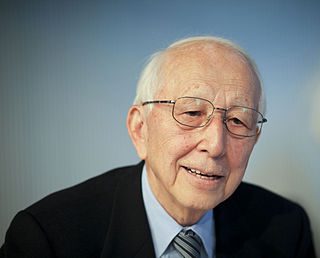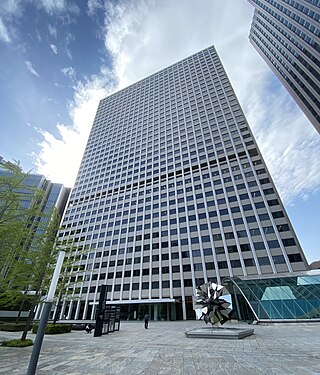
Kenzō Tange was a Japanese architect, and winner of the 1987 Pritzker Prize for Architecture. He was one of the most significant architects of the 20th century, combining traditional Japanese styles with modernism, and designed major buildings on five continents. His career spanned the entire second half of the twentieth century, producing numerous distinctive buildings in Tokyo, other Japanese cities and cities around the world, as well as ambitious physical plans for Tokyo and its environments.

Eamonn Kevin Roche was an Irish-born American Pritzker Prize-winning architect. Kevin Roche was the archetypal modernist and "member of an elite group of third generation modernist architects — James Stirling, Jorn Utzon, and Robert Venturi — and is considered to be the most logical and systematic designer of the group. He and his partner John Dinkeloo of the firm KRJDA produced over a half-century of matchless creativity."
Takenaka Corporation is one of five major general contractors in Japan. Takenaka provides architectural, engineering, and construction services and has its headquarters located in Chūō-ku, Osaka, Osaka Prefecture. Takenaka has eight domestic offices in Japan with overseas offices in Asia, Europe, and the United States. It has remained under family control since the founding of Takenaka Corporation in 1609, and is currently led by the 17th generation of the family.

Hiroshi Hara is a Japanese architect and author on architecture. His major works, including Kyōto Station, the Umeda Sky Building in Osaka, the Yamato International building in Tokyo, the Sapporo Dome in Hokkaidō, and other important structures in Japan, have earned many awards. With a doctorate in engineering, he was a professor at the University of Tokyo until 1997, and has held an emeritus position since that time.

Postmodern architecture is a style or movement which emerged in the 1960s as a reaction against the austerity, formality, and lack of variety of modern architecture, particularly in the international style advocated by Philip Johnson and Henry-Russell Hitchcock. The movement was formally introduced by the architect and urban planner Denise Scott Brown and architectural theorist Robert Venturi in their 1972 book Learning from Las Vegas. The style flourished from the 1980s through the 1990s, particularly in the work of Scott Brown & Venturi, Philip Johnson, Charles Moore and Michael Graves. In the late 1990s, it divided into a multitude of new tendencies, including high-tech architecture, neo-futurism, new classical architecture, and deconstructivism. However, some buildings built after this period are still considered postmodern.

Toyo Ito is a Japanese architect known for creating conceptual architecture, in which he seeks to simultaneously express the physical and virtual worlds. He is a leading exponent of architecture that addresses the contemporary notion of a "simulated" city, and has been called "one of the world's most innovative and influential architects."

Fumihiko Maki was a Japanese architect. In 1993, he received the Pritzker Prize for his work, which often explores pioneering uses of new materials and fuses the cultures of east and west. Maki died on 6 June 2024, at the age of 95.

César Pelli was an Argentine-American architect who designed some of the world's tallest buildings and other major urban landmarks. Three of his most notable buildings are the Petronas Towers in Kuala Lumpur, the World Financial Center in New York City, and the Salesforce Tower in San Francisco. The American Institute of Architects named him one of the ten most influential living American architects in 1991 and awarded him the AIA Gold Medal in 1995. In 2008, the Council on Tall Buildings and Urban Habitat presented him with The Lynn S. Beedle Lifetime Achievement Award.

Norma Merrick Sklarek was an American architect. Sklarek was the first African American woman to become a licensed architect in the states of New York (1954) and California (1962), as well as the first Black woman to become a member of the American Institute of Architecture (AIA). Her notable works include the United States Embassy in Tokyo, Japan (1976) and the Terminal One station at the Los Angeles International Airport (1984).Sklarek is credited with helping to pave the way for other female and minority architects. AIA board member Anthony Costello called her the “Rosa Parks of architecture” in the AIA newsletter.

Josiah Conder was a British architect who was hired by the Meiji Japanese government as a professor of architecture for the Imperial College of Engineering and became architect of Japan's Public Works. He started his own practice after 1888.

The Kasumigaseki Building is a 36-story skyscraper located in Kasumigaseki, Chiyoda, Tokyo.
Atsushi Kitagawara is a Japanese architect.
Kiyoshi Mutō was a Japanese architect and structural engineer. He is considered the "father of the Japanese skyscraper" for his contributions to earthquake engineering.
Jun Watanabe is a Japanese architect and a former professor at Chubu University.
Manabu Chiba is a Japanese architect from Tokyo. He received his master's degree from the University of Tokyo in 1987. He worked at Nihon Sekkei Inc. until 1993, when he became partner of Factor N Associates. He established Chiba Manabu Architects as principal in 2001.

Yoo Dong-ryong(Korean: 유동룡 伊丹 潤; 1937–2011), known professionally as Jun Itami, is a Korean architect from Japan. He was born in Tokyo 1937 to Korean parents and gained his degree in architecture at Musashi Institute of Technology in 1968. Itami Jun spent his childhood in Shizuoka, Japan and entered the world of architecture by traveling and encountering many other artists. With profound insight into objects, he learned and expressed architecture with the physical senses of touch and drawing as his medium. In the homogeneous industrial society, Itami Jun sought to practice contemporary architecture with an anti-modern bent, emphasizing purity of architecture and material, and pursuing heavy primitive architecture with a sense of rawness in the material. Itami Jun’s Jeju projects in his late years demonstrate the mature beauty of his architecture.
Mitsui Hachirōemon is the inherited name given to the first son born to the head family, or the leading branch of the extended Mitsui family. It was Mitsui Takatoshi (三井高利) who started the naming ritual that a male heir would be called Hachirōemon when they decide the next leader of family business that Mitsui was known for. For those sons of Takatoshi, each bloodline had a nickname: the first son Takahira held the Kita branch, the second son Takatomi the Isarago branch (伊皿子家), and the third son Takaharu the Shimmachi branch (新町家).

Takamitsu Azuma was a Japanese architect, and winner of the 1995 the Prize of AIJ. He was a follower of Le Corbusier and was one of the most significant architects of the 20th century, combining traditional Japanese styles with modernism, and designed new types of houses symbolized living in the metropolis.

Azabudai Hills is a complex of three skyscrapers in Tokyo, Japan. Upon its completion in 2023, the Azabudai Hills Mori JP Tower in the development became the tallest building in Tokyo and Japan.
Kokichi Yamaguchi was a Japanese architect active at The University of Tokyo.














